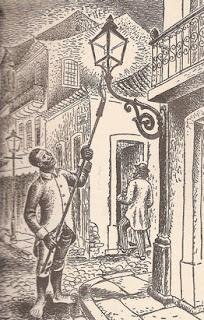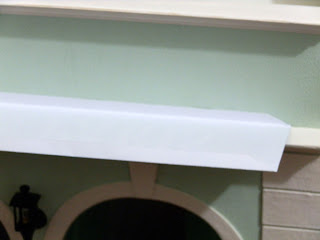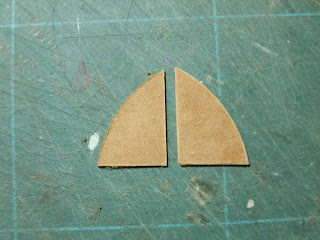My end of the 19th Century store will have lights! Whether there was electricity in RL stores back then, that's a whole other story... :) I did my research, and electricity arrived very slowly to homes & commercial buildings in Brazil. Our former emperor, the very beloved D. Pedro II, was quick to embrace the new technology, but soon after that he was deposed by the farmers elite + military, so that part of the progress was halted. Only in the 1920's electricity became gradually more common in homes. So, from 1847 to 1862 street lamps used oil. Then it was switched to gas. Only in 1905 the street lights began to be changed to electricity.
Acho sensato presumir, portanto, que dentro das lojas na década de 1890 usavam velas, iluminação a base de óleo ou então, em estabelecimentos chiques, gás. Pesquisei os candelabros mais usados na época e tive sorte em achar dois modelos funcionais em miniatura que se pareciam com os modelos que mais vi nas minhas pesquisas: um para o lado de fora e outro para o interior da loja. Comprei-os por valores bem razoáveis no ebay. Eba!!!
My assumption, then, was that inside stores they either used candles, oil or gas by the 1890's. I researched for the chandelier models back then and I was lucky enough to find two miniature models which looked like the ones I saw more often in my research: one to use outside the store, and the other one, inside. I bought them for a very reasonable price on ebay, so... happy, happy, happy! :)
O único problema era a cor do metal usado!
The only problem was with the metal color!
Para os lampiões que iam do lado de fora, queria que tivessem um aspecto de ferro batido (mais baratos e mais comuns na época)... Então desmontei as lâmpadas, passei um spray de verniz preto fosco e remontei depois de secos.
Outside, I wanted them to look more like wrought iron (less expensive & more commonly used)... So I dismantled the fixtures, removed the little lamps and sprayed them with matte black varnish.
Para os candelabros do interior da loja, eu queria um aspecto de latão ou cobre (novamente, menos caros que o metal dourado e mais comuns - apesar de mais 'chiques' que o ferro batido)... Então, novamente, desmontei as luminárias, removendo cuidadosamente as lâmpadas e as partes de plástico, e pintei com verniz vitral fumê. Como não é à base de água, usei um micro-pincel descartável (desses que os dentistas usam), pois detesto usar solvente para limpar meus pincéis - acho que acabam estragando os pincéis! (sem contar com o cheiro horrível e tóxico...)
Inside, I wanted them to look more like brass or copper (again, less expensive than any golden metal & more commonly used - though fancier than iron)... So I once more dismantled the fixtures, removed the little lamps and the plastic tulips and painted them carefully with sepia varnish meant to be used on glass. It's not water based, so I used a disposable micro brush (those used by dentists), as I hate using spirits to clean my brushes - I think it ends up ruining them!! (not to mention the toxic fumes...)
Bem, gostei do resultado! :)
I like the result!!! :)
O problema agora é que eu deveria ter preparado os canais para acomodar os fios antes de ter colado o roda-teto - que tonta!!! Bem, tarde demais para me lamentar. Então eu fiz um furo no roda-teto, bem rente à parede.
The problem now was that I should have prepared the grooves for the wires before I glued the ceiling moulding - silly me!!! Well, too late to be sorry. I then drilled a hole through it, very close to the wall.
No processo, fiz um pequeno estrago em uma parte da parede acima do roda-teto. Mas consegui consertar com um preenchimento e pintura.
In the process, I did some damage above the moulding, which I managed to fix later with plaster filling & paint.
Hora então de instalar as lâmpadas externas. Passando os fios pelo buraco...
So, time to install the outside fixture. Wires in...
E subindo pelos canais! Para passar pelo buraquinho do roda-teto, usei um artifício usado por eletricistas da escala normal: um arame fino com um ganchinho na ponta, amarrei os fios e puxei.
And up! To help the wires go through the tiny hole in the mouldings, I used a trick I saw a real-life electrician do: I used a thin wire with a little hook on the tip. I attached the wires from the lamps there and pulled the wire. Voilá!
Colei no lugar e cobri com preenchimento. Depois de seco, um pouco de lixa e tinta. O 'remendo' quase nem aparece...
I then glued them to place and covered the grooves with plaster. After dry, sanded and painted. One almost doesn't see the work done there...
E é assim que as lâmpadas externas ficaram. Fique ligado para ver as luzes inernas e para vê-las em funcionamento! :)
This is how the outside lamps look like. Stay tuned for the lights inside & to see them lit! :)

















































